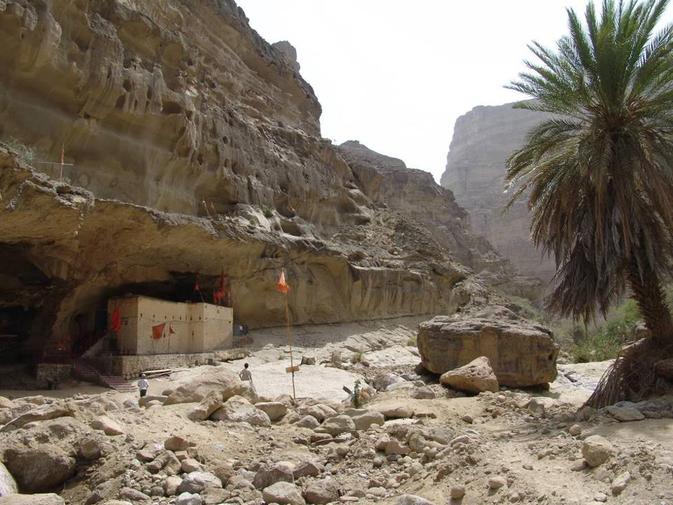
Shakti Peeth - Hinglaj (Or Hingula)
Hinglaj is an important Hindu pilgrimage place in Balochistan, Pakistan and Kuldevi of Kshatriya Bhavsar Community. It is situated in Balochistan province about 250 km north-west of Karachi. The site has become a beacon of proof of the Baloch secular religious attitude particularly towards the Hindu pilgrim’s even though the majority of the populace are Muslims. The autonomous region which has sought separation from the Pakistani Central government since the division of Hindustan (India).
Yet since 2001 it has been associated with the NWFP and FATA regions as a hotbed for religious extremism to the dismay of the locals. In 2006 the leader of the Baloch National Front, Sardar Akbar Khan Bugati was assasinated by the Pakistani army whom have faced an increase in underground insurgency that the Pakistani government alleges to be masterminded from Afghanistan.
On the other hand the area of Balochistan is also significant of Indo-Pakistani relations, the government insisted that the Baloch insurgency is supported by India to circulate influence in the region and that it is also home to countless Indian spooks and Afghan taliban, yet places like Hinglaj Mandir indicates the religious tolerance of the Baloch state.
To still the divine dance, Tandava, of Lord Shiva following the death of Dakshayani, Lord Vishnu scattered the remains of her embodiment over various places of the Indian subcontinent. It is said that the head fell at Hingula or Hinglaj and is thus considered the most important of the 51 Shakti Peeths.
At each of the Peeths, Bhairava (a manifestation of Shiva) accompanies the relics. The Bhairava at Hinglaj is called Bhimalochana, located in Koteshwar, Kutch. The Sanskrit texts mention the part as 'Brahmadreya' or vital essence.
In the Ramayana, after slaying Ravana, Lord Ram came to Hinglaj to atone for his sin of 'Brahmhatya' (killing a Brahmin). Ravana was a Brahmin and a great devotee of Lord Shiva and Durga. Lord Ram meditated at Hinglaj as it was a very important shrine.
The mantra or incantation for Devi Hinglaj is attributed to Saint Dadhichi, an important saint in Hindu theology.
The mantra is :
ॐ हिंगुले परमहिंगुले अमृतरूपिणि तनुशक्ति
मनः शिवे श्री हिंगुलाय नमः स्वाहा
OM HINGULE PARAM HINGULE AMRUTRUPINI TANU SHAKTI
MANAH SHIVE SHREE HINGULAI NAMAH SWAHA
Translation : "Oh Hingula Devi, she who holds nectar in her self and is power incarnate. She who is one with Lord Shiva, to her we pay our respects and make this offering (swaha)."
Yet another incarnation:
ब्रह्मरंध्रम् हिंगुलायाम् भैरवो भीमलोचन: |
कोट्टरी सा महामाया त्रिगुणा या दिगम्बरी ||
BRAHMARANDHRAM HINGULAAYAAM BHAIRAVO VIMALOCHANAH
KOTTARI SAA MAHAAMAAYAA TRIGUNAA YAA DIGAMVARI
Translation : "Mahaamaayaa (Queen of Illusions) who represents the supreme virtue by reigning over all three virtues, has Bhimalochana as her Bhairava, and derides the worldly trappings by dancing naked, resides in this cave of Hingula that enshrines her sacred head."
Shrine's mark
The shrine is recognised by a mark which resembles the sun and the moon. This mark is upon a giant boulder at the top of the hill containing the cave. It is believed that Lord Ram created this mark with the strike of his arrow after his penance ended.
Hinglaj is an important Hindu pilgrimage place in Balochistan, Pakistan and Kuldevi of Kshatriya Bhavsar Community. It is situated in Balochistan province about 250 km north-west of Karachi. The site has become a beacon of proof of the Baloch secular religious attitude particularly towards the Hindu pilgrim’s even though the majority of the populace are Muslims. The autonomous region which has sought separation from the Pakistani Central government since the division of Hindustan (India).
Yet since 2001 it has been associated with the NWFP and FATA regions as a hotbed for religious extremism to the dismay of the locals. In 2006 the leader of the Baloch National Front, Sardar Akbar Khan Bugati was assasinated by the Pakistani army whom have faced an increase in underground insurgency that the Pakistani government alleges to be masterminded from Afghanistan.
On the other hand the area of Balochistan is also significant of Indo-Pakistani relations, the government insisted that the Baloch insurgency is supported by India to circulate influence in the region and that it is also home to countless Indian spooks and Afghan taliban, yet places like Hinglaj Mandir indicates the religious tolerance of the Baloch state.
To still the divine dance, Tandava, of Lord Shiva following the death of Dakshayani, Lord Vishnu scattered the remains of her embodiment over various places of the Indian subcontinent. It is said that the head fell at Hingula or Hinglaj and is thus considered the most important of the 51 Shakti Peeths.
At each of the Peeths, Bhairava (a manifestation of Shiva) accompanies the relics. The Bhairava at Hinglaj is called Bhimalochana, located in Koteshwar, Kutch. The Sanskrit texts mention the part as 'Brahmadreya' or vital essence.
In the Ramayana, after slaying Ravana, Lord Ram came to Hinglaj to atone for his sin of 'Brahmhatya' (killing a Brahmin). Ravana was a Brahmin and a great devotee of Lord Shiva and Durga. Lord Ram meditated at Hinglaj as it was a very important shrine.
The mantra or incantation for Devi Hinglaj is attributed to Saint Dadhichi, an important saint in Hindu theology.
The mantra is :
ॐ हिंगुले परमहिंगुले अमृतरूपिणि तनुशक्ति
मनः शिवे श्री हिंगुलाय नमः स्वाहा
OM HINGULE PARAM HINGULE AMRUTRUPINI TANU SHAKTI
MANAH SHIVE SHREE HINGULAI NAMAH SWAHA
Translation : "Oh Hingula Devi, she who holds nectar in her self and is power incarnate. She who is one with Lord Shiva, to her we pay our respects and make this offering (swaha)."
Yet another incarnation:
ब्रह्मरंध्रम् हिंगुलायाम् भैरवो भीमलोचन: |
कोट्टरी सा महामाया त्रिगुणा या दिगम्बरी ||
BRAHMARANDHRAM HINGULAAYAAM BHAIRAVO VIMALOCHANAH
KOTTARI SAA MAHAAMAAYAA TRIGUNAA YAA DIGAMVARI
Translation : "Mahaamaayaa (Queen of Illusions) who represents the supreme virtue by reigning over all three virtues, has Bhimalochana as her Bhairava, and derides the worldly trappings by dancing naked, resides in this cave of Hingula that enshrines her sacred head."
Shrine's mark
The shrine is recognised by a mark which resembles the sun and the moon. This mark is upon a giant boulder at the top of the hill containing the cave. It is believed that Lord Ram created this mark with the strike of his arrow after his penance ended.
 RSS Feed
RSS Feed

